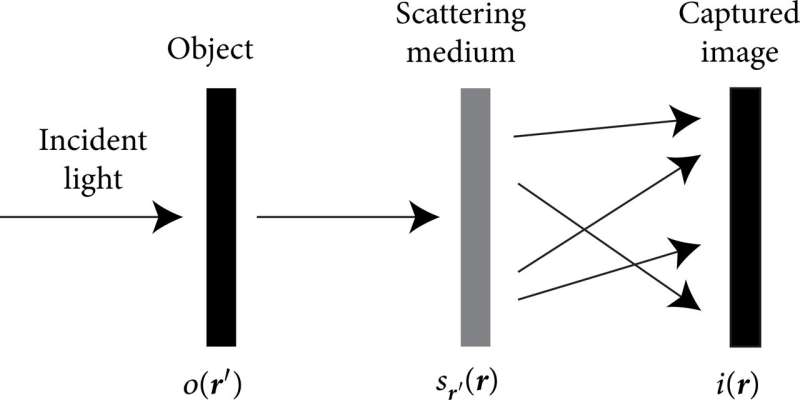Optical model in the proposed method. Credit: Intelligent Computing (2022). DOI: 10.34133/2022/9787098
Trying to see through scattering media like haze and fog is often accompanied by disappointment or even difficulties in our daily lives—if you have ever experienced a sunrise-watching trip on a cloudy morning or a palm-sweating drive through dense fog. For researchers in optics and photonics, seeing through scattering media is also a long-standing challenge in a broad range of application scenarios, such as microscope imaging through biological tissues and telescopic observation through atmospheric turbulence.
To address the challenge, speckle-correlation imaging has been developed as an emerging technique with a noninvasive nature and a minimal optical setup, which are advantages over established approaches like wavefront shaping and transmission matrix, despite their abilities of imaging through strongly scattering media.
However, speckle-correlation imaging is not always practical. It works on the premise of a physical property called memory effect—assumed shift invariance of the speckle pattern during the scattering process, which is known to be severely limited when the medium is thick.
Recently, researchers from the University of Tokyo and Osaka University have worked out a promising solution for speckle-correlation imaging to function properly under a limited memory effect. They published their research in Intelligent Computing on Sept. 30.
"An issue with speckle-correlation imaging was the small field of view due to a limited range of the memory effect when the scattering medium was thick," the researchers pointed out.
To overcome the bottleneck, they proposed a method for extending the field of view of single-shot speckle-correlation imaging. "The proposed method takes account of the decay of the speckle correlation under a limited memory effect and extrapolates the correlation in the reconstruction process," the researchers explained.
"Our method simultaneously estimates both the object and the decay of the speckle correlation based on the gradient descent method."
The proposed method was then demonstrated numerically and experimentally, with both the proposed algorithm (with the decay function considered) and the conventional one (without the decay function considered) applied during the reconstruction process for comparative reference.
In the experiment, the researchers reconstructed point sources behind scattering media using a minimal optical setup, without any imaging optics: from left to right, there was incoherent light, a bandpass filter, a diffuser, an object (a piece of aluminum foil with 15 holes) illuminated by the diffused light, another diffuser, and an image sensor capturing the light passing through the object.
After comparatively analyzing the reconstructed images obtained by the proposed and the conventional algorithms respectively, the researchers found out the proposed algorithm recovered a larger field of view compared with the conventional algorithm, and its estimated decay parameter agreed with the actually measured one.
"This result verified our concept of speckle-correlation imaging with the extended field of view by extrapolating the limited autocorrelation," the researchers concluded.
This proposed method, according to the researchers, is readily applicable to conventional speckle-correlation imaging methods without any optical modifications. Furthermore, this method of single-shot speckle-correlation imaging is also extendable to multidimensional speckle-correlation imaging and, as a result, will contribute to imaging applications in various fields, such as biomedicine, astronomy, and security.
More information: Yuto Endo et al, Extrapolated Speckle-Correlation Imaging, Intelligent Computing (2022). DOI: 10.34133/2022/9787098
Provided by Intelligent Computing
























